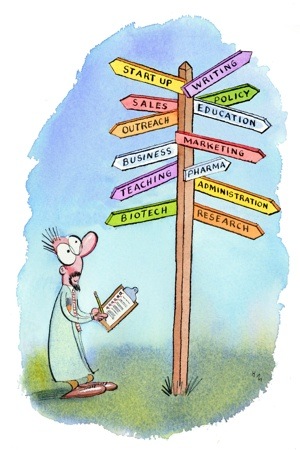
by Lisa A. Rossbacher Monday, February 11, 2013

©myIDP.sciencecareers.org, AAAS
Early in the 1990 film “Tremors,” the character Earl criticizes his colleague, played by Kevin Bacon, for not having a plan. “Valentine, you never plan ahead. You never take the long view. I mean, here it is Monday, and I’m already thinking of Wednesday,” Earl says. “It is Monday, right?”
Of course, “Tremors” has a lot going for it: funny dialog, great scenery, monster subterranean worms, a female seismologist, and, of course, Kevin Bacon. But the messages about planning ahead whenever possible and improvising when necessary are ones that every earth scientist will appreciate.
When I was in college, few of us had serious professional plans. We assumed that jobs — and careers — would appear when we graduated. Most of us found the Career Center on campus when we walked in a few weeks before graduation and simply stated, “I need a job.” Biology majors became biologists. Geology majors became geologists — in academia, the petroleum industry, or for the U.S. Geological Survey or a state survey.
Over the years, I’ve seen many people use the “spaghetti” approach to figuring out which career to pursue: throwing many random ideas against the wall to see what sticks. If a job worked out, that was great. If not, they would cast more applications into the world and try something new. This approach is neither thoughtful nor productive, and it often wastes the time and energy of both the job seeker and employers.
Today, the sheer volume of available data makes an organized approach to careers even more critical. And, of course, the economic climate means planning has become increasingly important.
A tool that may benefit geoscientists is something that the business world has long been aware of — individual development plans, or IDPs. IDPs engage an employee in an action plan, which may involve addressing weaknesses, leveraging strengths, or both. These plans are valuable for outlining goals and for preparing for opportunities to grow in a position. They are often used in addition to, or in lieu of, annual performance assessments. But IDPs have value beyond helping develop a plan for the coming year. They can also help geoscientists map the best fit between their skills and interests and available career paths.
A new Web-based tool, called myIDP, which is supported by the science careers program at the American Association for the Advancement of Science, may prove useful. Found at myIDP.sciencecareers.org, the tool is free and confidential. Participants will find informative articles on a variety of topics and assessment tools that have a series of questions to help identify talents and interests. The outcome is a suggested list of careers to consider, along with the opportunity to create a personalized development plan and a mechanism for holding oneself accountable with email reminders.
The authors of myIDP have expanded ideas from career planning in the life sciences to include the natural and physical sciences, as well as engineering. Their approach assumes that the career will be in science or engineering, and their primary target audience is graduate students and post-docs. However, this approach also has value for scientists who are further along in their careers and looking for fresh ideas, considering new directions or thinking about how to re-energize an existing career. The tool can also be a powerful asset in advising and mentoring students and colleagues. Although the information on the website is confidential, participants may find value in selectively sharing the assessment results with advisors and mentors to generate valuable discussion and useful insights.
The website takes the participant through a series of assessment questions — about skills, interests and values — and then suggests a list of suitable career possibilities. The site also offers ideas for how to develop a plan to achieve very specific targets aimed at career opportunities. In some ways, the advice transcends the sciences and engineering. Holding oneself accountable, establishing detailed goals and understanding the value of being engaged in both teamwork and individual undertakings are useful reminders for anyone. When I took the assessments myself, I was reassured to discover that my top three matches for career paths were science policy, science education for nonscientists and science writing. Those all seem like realistic possibilities.
As pointed out in a September 2012 editorial in Science about myIDP, people interested in careers in science and engineering generally have excellent analytical skills. Creating an IDP is an opportunity to apply these skills to benefit one’s own future. This particular website isn’t the only way to approach the process, but it is a good one that is specifically tailored to scientists and engineers. And the resulting plan is likely to produce a stronger sense of direction and purpose than will disorganized running in multiple directions.
As Earl also noted in “Tremors”: “Running’s not a plan. Running’s what you do once a plan fails.”
© 2008-2021. All rights reserved. Any copying, redistribution or retransmission of any of the contents of this service without the expressed written permission of the American Geosciences Institute is expressly prohibited. Click here for all copyright requests.